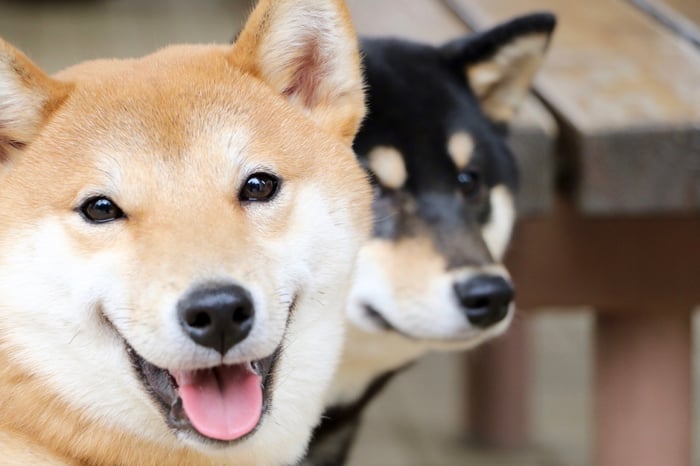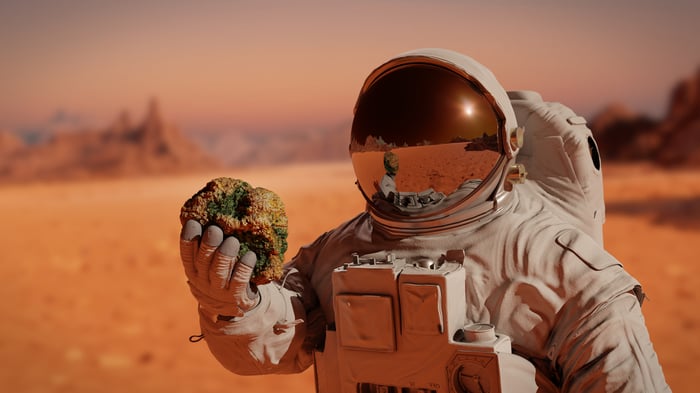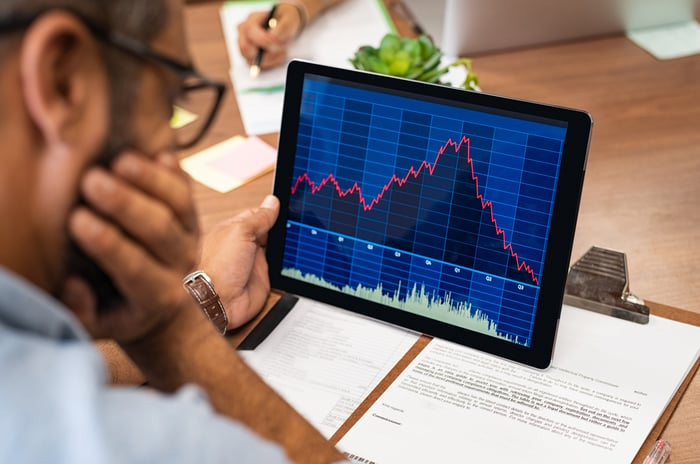When 2021 officially ended, cryptocurrencies once again ascended to the top of the pedestal. After beginning the year with an aggregate value of $774 billion, the total worth of more than 16,000 cryptocurrencies hit close to $2.2 trillion. That's a near-tripling in value for the crypto market.
What's clear from this increase is that investors are excited about the financial and nonfinancial applications of blockchain, the future of a potentially decentralized metaverse, and the transparency that blockchain technology brings to the table.
But when there are more than 16,000 digital currencies to choose from, there are bound to be pretenders mixed in. Although the following four cryptocurrencies were especially popular last year, they fall into the pretender category and should be avoided like the plague in 2022.

Avoid any tokens inspired by the Shiba Inu in 2022. Image source: Getty Images.
Shiba Inu
If there's one very simple theme I can pass along to cryptocurrency investors in 2022, it's to avoid any coins based on the Shiba Inu dog breed or named after Elon Musk. Topping the list of digital currencies to avoid like the plague is none other than Shiba Inu (SHIB -4.87%).
Last year, Shiba Inu delivered historic gains. At one point, in late October, SHIB tokens were up by 121,000,000% in less than a year. This meant the change in your pocket could have made folks millionaires, if they bought at midnight on Jan. 1, 2021.
Shiba Inu's historic gains were driven by increased visibility in the form of more exchanges accepting SHIB for trading, the launch of ShibaSwap, landing a handful of brand-name merchants, and the fear of missing out (FOMO). That last one is particularly important, as social media hype has played a role in pumping the valuations of all four of the digital currencies on this list higher.
However, Shiba Inu has three key flaws. The biggest issue is it has no competitive advantages and offers no differentiation (social media pumping isn't differentiation). It's just an ERC-20 token built on the Ethereum blockchain that's subject to the same high transaction fees and processing lag that can affect the Ethereum network.
Second, it lacks real-world utility. Even with Shiba Inu consistently among the 15 largest digital currencies by market cap, it still doesn't have 400 merchants willing to accept its token, according to data from online business directory Cryptwerk. Without a competitive edge or differentiation, there's simply no reason for businesses to want to take SHIB as payment.
And third, history shows that life-altering gains in the crypto space are met by equally epic reversions. This suggests SHIB is headed for the doghouse in 2022.

Image source: Getty Images.
Dogelon Mars
I repeat: Don't buy cryptocurrencies inspired by the Shiba Inu or Elon Musk. That's why Dogelon Mars (ELON -4.47%) (pronounced "Dog-a-lon") makes the list of digital currencies to avoid in 2022.
The first clue that you might be buying into a project with absolutely no real utility can be found in its mission statement. Although the home page of Dogelon Mars has recently been revamped, it previously noted that Dogelon is "the first interplanetary currency." The mission statement also alluded to the project "send[ing] tokens over time to victims of rugs and scams." A "rug" or "rug pull" describes an event in which the developers of a cryptocurrency take investors' money and disappear.
To start with the basics, there's absolutely no need for an interplanetary currency. No human has visited another planet, let alone colonized it to the point where currencies would be needed. The fact that Dogelon Mars was even described as an "interplanetary currency" is insulting to the intelligence of the investment community.
Additionally, I can't even find information on how many businesses accept Dogelon Mars as a form of payment. That's a pretty good indicator that this payment coin isn't being used by many businesses worldwide, if any. Outside of a small number of crypto exchanges, its ELON token has no real-world use.
Let's also not overlook that Dogelon Mars has popped and fizzled before. In a three-week stretch last year (April 22 to May 11, 2021), ELON surged more than 6,200%, but wound up losing 97% of its value in the subsequent six weeks. These illiquid, social media hyped tokens are best avoided.

Image source: Getty Images.
Floki Inu
In case you've been skimming, I'll say it again: Don't buy meme coins inspired by Shiba Inus or Elon Musk. This includes Floki Inu (FLOKI -5.72%), which is named after Elon Musk's adopted Shiba Inu, Floki.
The buzz surrounding Floki Inu looks to be misappropriated. Though FLOKI tokens seemingly soar every time Tesla CEO Elon Musk tweets about Shiba Inus, Musk has absolutely nothing to do with the project. Musk's brother, Kimbal Musk, is involved with the Million Gardens movement, which is designed to address world hunger issues -- and FLOKI is part of that, too. But let's be real here: Investors aren't piling in because of what Kimbal Musk thinks or tweets.
Another issue with Floki Inu (and the other coins on this list) is its lack of real-world utility. The FLOKI white paper notes a partnership with CryptoCart, which allows FLOKI holders to spend their tokens in approximately 1,700 stores. The problem is there are more than 500 million entrepreneurs globally, meaning 1,700 stores are a fraction of a fraction in the grand scheme of usefulness.
To build on this point, most businesses aren't willing to take FLOKI. The deals being struck by many of these obscure coins allow third-party providers to exchange one coin, like FLOKI, for the currency that a business is willing to accept, such as U.S. dollars, for a fee. There aren't 1,700 businesses worldwide with signs on their doors saying they'll take Floki Inu as a form of payment.
There have also been concerns about Floki Inu's aggressive advertising campaign in the United Kingdom. Regulation surrounding crypto advertising is constantly evolving, and Floki Inu could draw unwanted attention from U.K. lawmakers.
Long story short, it's a token that can easily be avoided in 2022.

Image source: Getty Images.
Dogecoin
The fourth and final cryptocurrency to avoid like the plague this year is Dogecoin (DOGE -5.82%). And yes, Dogecoin's two developers were inspired by the Shiba Inu dog breed. Stop buying Shiba Inu-themed coins!
Unlike Floki Inu, Dogelon Mars, and Shiba Inu, all of which have ripped higher from misappropriated Elon Musk tweets, Dogecoin does have a bit of a connection to the world's richest person. Elon Musk owns only three digital currencies, one of which is Dogecoin. He's also previously tweeted that he's working with Dogecoin's developers to improve the network. This has given Dogecoin just a hair more credence in its move up than the other three tokens.
However, Dogecoin, like the other cryptocurrencies listed here, is completely devoid of competitive advantages or differentiation. While its transaction fees are lower than those of Bitcoin and Ethereum, Dogecoin's fees are also consistently much higher than pretty much every other popular payment coin.
What's more, the Dogecoin blockchain isn't particularly fast, doesn't offer any jaw-dropping ability to scale, and in September saw the average number of transactions completed daily fall to a three-year low (about 20,000 per day). Payment giant Visa is capable of processing what Dogecoin has been handling per day on its blockchain in just one second.
Furthermore, to keep with the theme, very few businesses are willing to accept DOGE as a form of payment. Cryptwerk lists fewer than 2,000 merchants worldwide as accepting it. Though that's five times higher than SHIB, it's an embarrassingly low figure eight years after its debut.
Dogecoin, like Shiba Inu, Dogelon Mars, and Floki Inu, are all in danger of losing most of their value in 2022.





